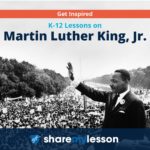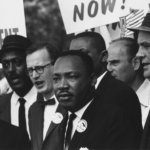In this lesson, students will experience unequal treatment first hand – some will receive a sticker based on an arbitrary characteristic, like hair color – and by discussing their reactions, they will come to understand the meaning of equality. Students will learn about the life and dream of Dr. Martin Luther King and write about what his dream for equality means in their own lives.
Realizing the Dream Today
Students will analyze a political cartoon depicting Dr. Martin Luther King Jr. and the title of his famous speech, “I Have a Dream.” Discussion of the meaning of the cartoon leads into a more general conversation about rights and equality.
Dr. King’s Dream

In this lesson, students will learn about the life and work of civil rights leader Martin Luther King, Jr. Students will listen to a brief biography, view photographs of the March on Washington, hear a portion of King’s “I Have a Dream” speech, and discuss what King’s words mean to them. Finally, they will create picture books about their own dreams of freedom for Americans today. (Duration: 3 class periods)
Competing Voices of the Civil Rights Movement
When most people think of the Civil Rights Movement in America, they think of Martin Luther King, Jr. delivering his “I Have a Dream” speech on the steps of the Lincoln Memorial in 1963 and receiving the Nobel Peace Prize the following year. But “the Movement” achieved its greatest results — the 1964 Civil Rights Act and the 1965 Voting Rights Act — due to the competing strategies and agendas of diverse individuals. Even black Americans, the primary beneficiaries of this landmark legislation, did not agree on the tactics that should be used to secure the equal protection of their rights. This unit presents the views of several important black leaders who shaped the debate over how to achieve freedom and equality in a nation that had long denied a portion of the American citizenry the full protection of their rights.
Martin Luther King Lesson Plans and Resources: Understanding a Life and Legacy

Education was integral to Dr. King’s vision for a more just society, and working to ensure that dream comes true is integral to America’s educators today. Share the influential ideas of this towering figure of the civil rights movement who envisioned racial, economic and social justice for America by espousing non-violent, collective action that would change society forever. Share My Lesson’s updated collection features curated lesson plans, resources and activities to help your prek-12 students explore Dr. King’s commitment to the labor movement and the fight for justice and dignity.
March on Washington: Lesson Plans & Resources

On August 28, 1963, approximately 250,000 people participated in the March on Washington for Jobs and Freedom, which is considered to be one of the largest peaceful political rallies for human rights in history. Among other events, the march participants gathered at the Lincoln Memorial to hear Martin Luther King Jr. deliver his iconic “I Have a Dream” speech. Many consider The Great March on Washington to be the event that encouraged the passage of the Civil Rights Act of 1964 and the Voting Rights Act of 1965. The Share My Lesson team has created this collection of free lessons and classroom materials to help middle and high school educators teach their students about this historic event.
I Have a Dream: Celebrating the Vision of Martin Luther King, Jr.

EDSITEment feature highlighting resources, activities, and lesson plans to help teachers, students, parents, and caregivers understand the impact Dr. King had — and continues to have — upon our country and the global efforts towards peace and civil rights.
On the third Monday of January, Americans celebrate the life and achievement of one of our most respected citizens — Martin Luther King, Jr. Dr. King was a leading force in the drive for civil rights in the United States, and he showed through words and actions that non-violent, persistent activism can achieve tremendous results by appealing to the moral conscience of Americans.